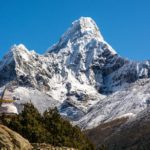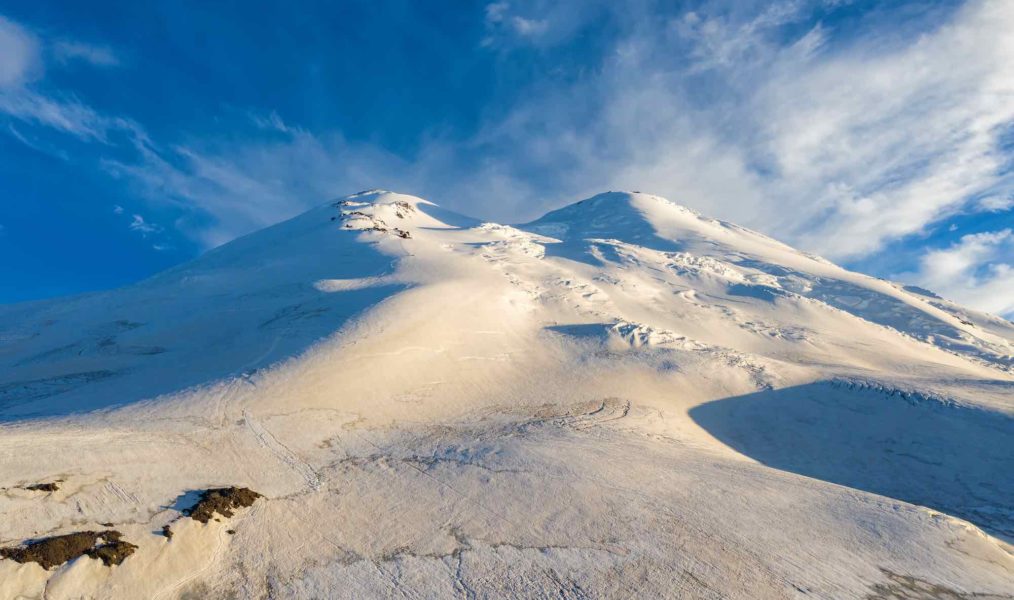
OVERVIEW
At 5642m high, Elbrus is Europe’s highest mountain and significantly higher than Mont Blanc (4808m) which as the highest mountain in the Alps is sometimes mistakenly believed to hold that title. A dormant volcano located in the beautiful Caucasus mountains, Elbrus has two summits with the higher, western top standing 20m above its eastern twin. A popular objective for climbers looking to experience higher-altitude climbing outside of Europe, it is considered to be the second easiest (after Kili) of the Seven Summits list. A challenging trip, what the peak lacks in technical difficulty it makes up for with often cold and windy unsettled weather. As with many of Europe’s highest mountains, the first ascent was made during the Golden Age of Alpinism during the second half of the 19th Century. And as was common at the time, the first ascentionists were British climbers led by a Swiss guide, in this case a team including Horace Walker and Crauford Grove, Alpine Club members who had made the first ascents of peaks including the Grand Jorasses, Zinalrothorn and Obergabelhorn.
ROUTES
The South side
Both of the main routes to the summit of Elbrus involve walking on moderately steep snow-covered glaciers, with crevasses and the notoriously fickle weather posing the major hazards. The south flanks of the mountain are home to the most often followed route, and are equipped with refuges and a cable car system which takes climbers up to 3800m. From the top of the cable car system a fairly direct route is followed to the summit, with teams sometimes taking a ‘snow cat’ truck to a higher point on the summit day which they have previously walked to whilst acclimatising. This route is a popular ski mountaineering objective too. With altitude and weather taken into account the ascent is worthy of respect, which makes the fact that it has been ascended several times on horseback, facilitated by specially- made horse crampons, even more impressive!
The North side
The north side of Elbrus is a much wilder experience than its southern counterpart. Instead of ski lifts and snow cats, a base camp at the foot of the mountain is the extent of the infrastructure. Teams tend to spend several days acclimatising by making excursions higher onto the mountain before making a summit bid all the way from base camp, a big day with over 1900m of ascent. Climbing either the north or south side of the peak and then descending the other makes for a fantastic journey, experiencing both its faces.
East Ridge
Less travelled than either of the main routes, the East ridge involves a mutli-day camping trip starting from 1800m. With easy scrambling on rock and walking on steeper snow and glacial ice it offers a much more adventurous route to the lower east summit.
HOW TO GET THERE
Fly to Moscow or St Petersburg, from where an internal flight to Mineralnye Vody from where a three to four hour drive gets you to Terskol, the town at the foot of Elbrus.
PERMITS
Due to Elbrus’ location near the Russian/Georgian border a border permit is needed, along with a National Park Permit. The red tape doesn’t stop there; you’ll need a tourist visa to enter Russia which can take several months to obtain, for which you’ll need a letter of invitation from a Russian travel agency.
RECOMMENDED OUTFITTERS
There are numerous companies offering assistance in climbing Elbrus, from logistics- only packages to get you and your bags to the mountain, to fully guided, all-inclusive trips to the summit. It’s possible to organise logistics directly with a Russian agency, or to go with a Western-led guiding company (such as www.jagged-globe.co.uk) who typically offer a greater level of support. Potential climbers should work out the level of support that they need, before doing lots of research to find a good provider.
Further resources:
Summit Post
UK Climbing
Camp 2 Camp






